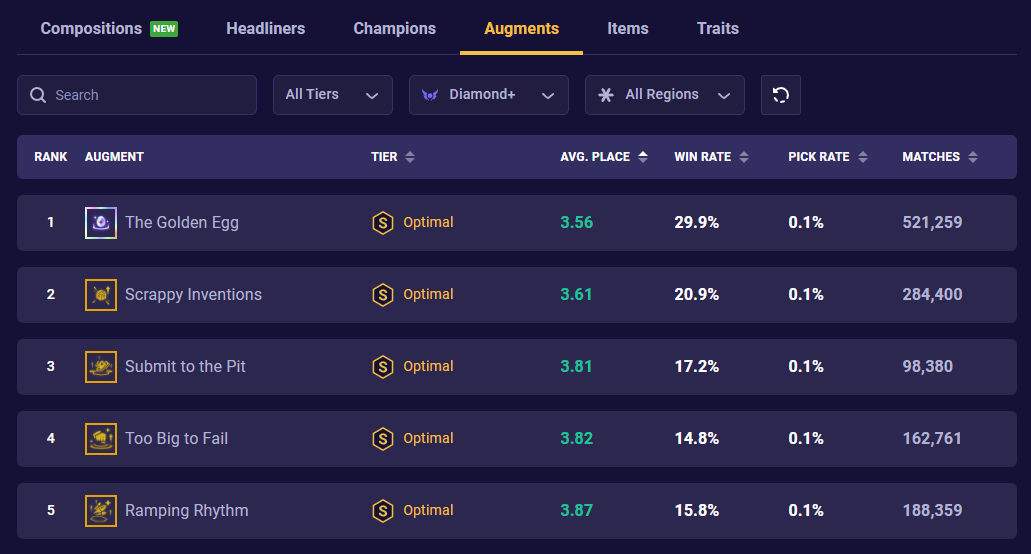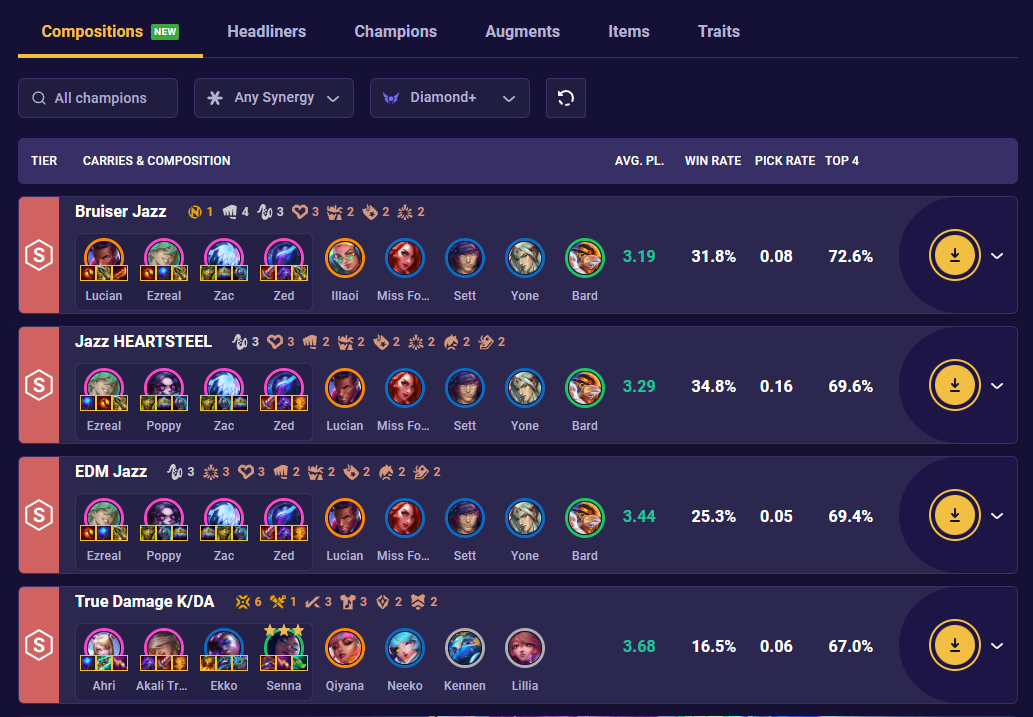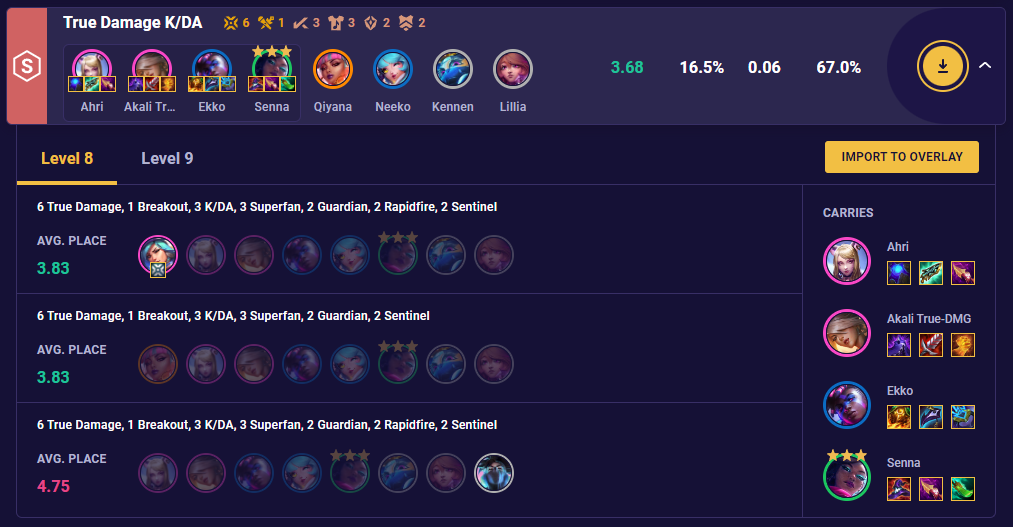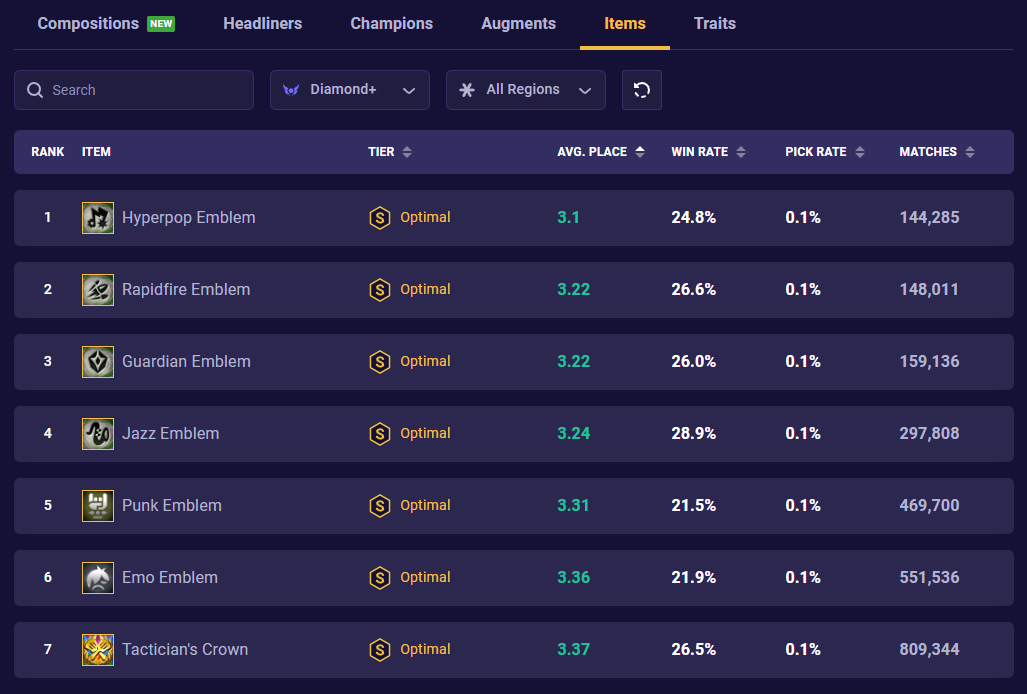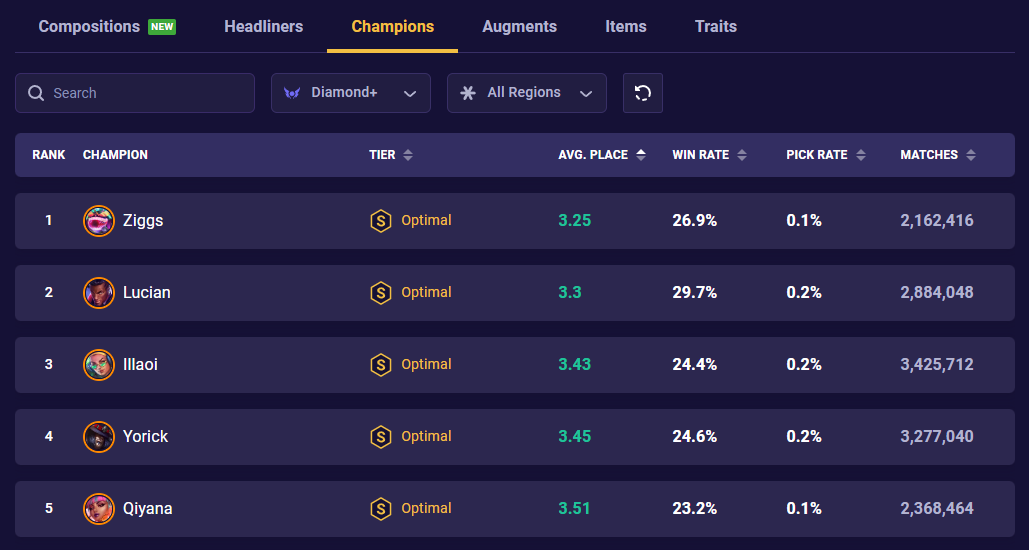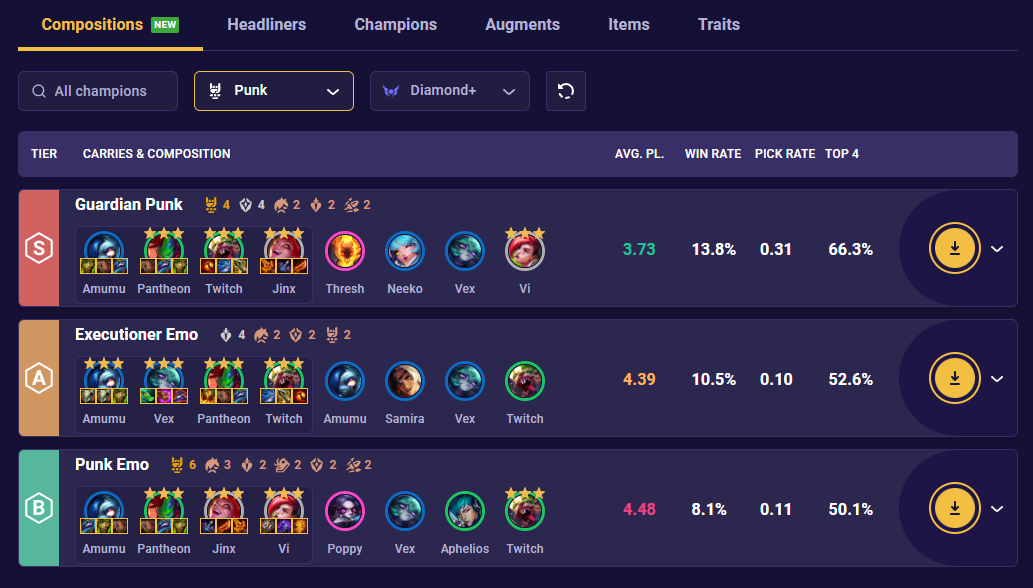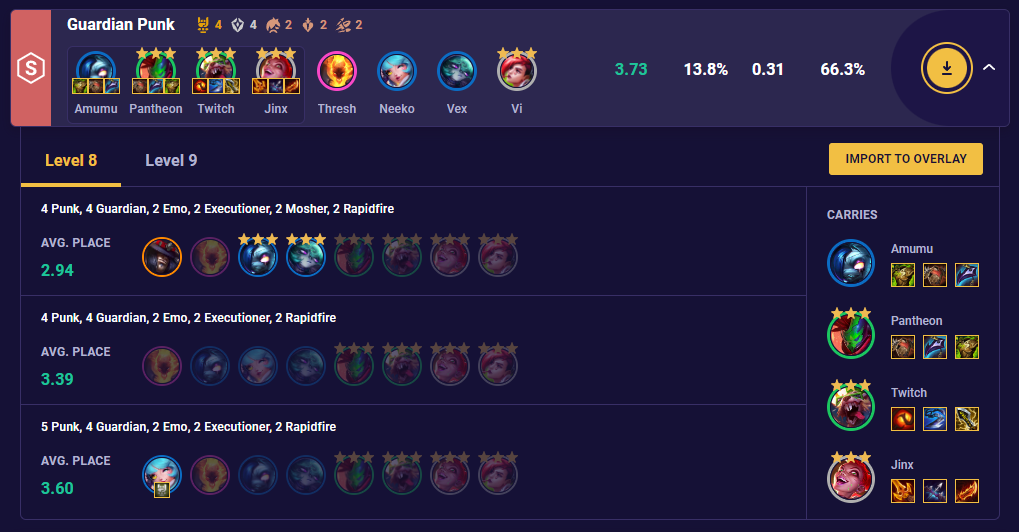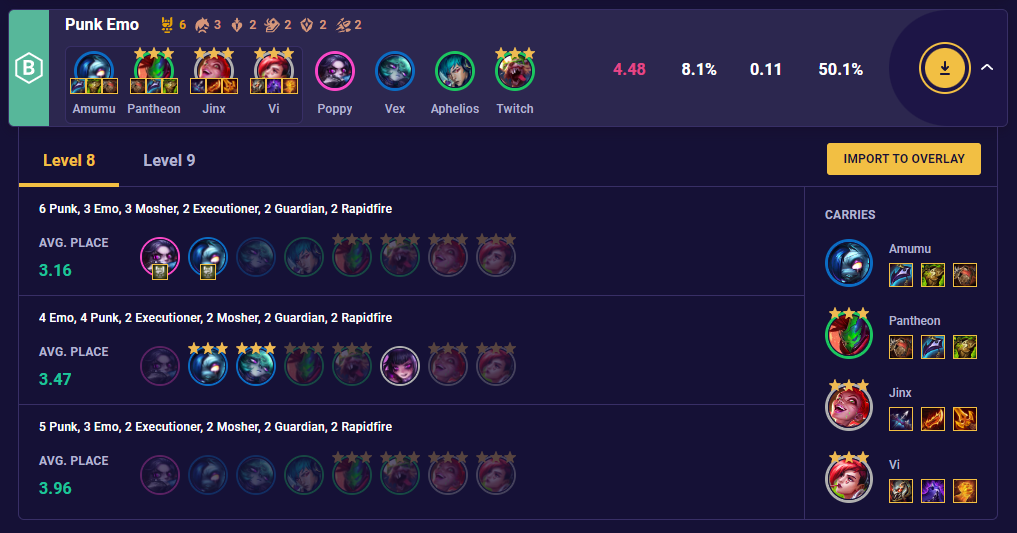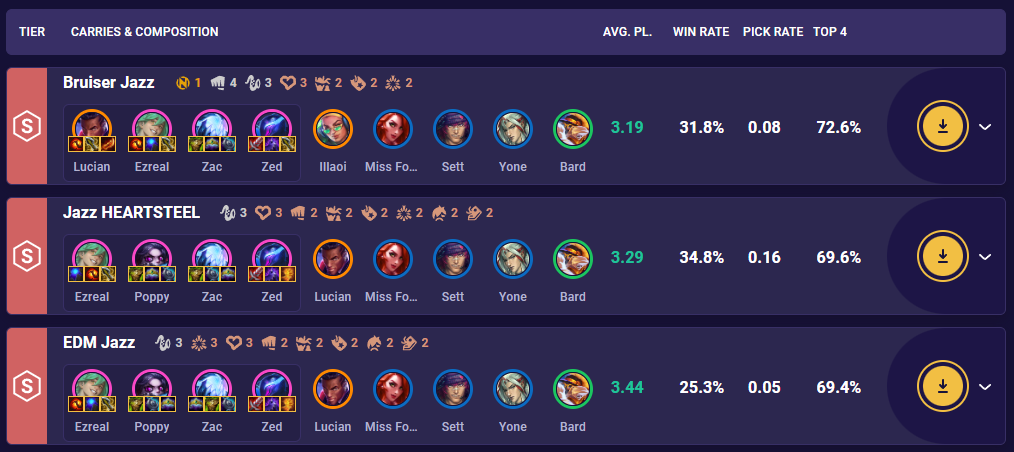How to Use Stats in TFT
In this guide, I’ll be covering our TFT Stats Feature and how to best utilize it. Statistics are a very powerful tool for improving just about anything. When it comes to TFT, stats can be very beneficial for improving your games. However, you also don’t want to just blindly follow stats.
We have a Meta Tier List curated by experts in TFT, but Stats can also paint a different picture. I’ll cover some easy ways to improve your game with stats, how to analyze stats deeper, and some pitfalls to avoid.
Let’s get right into the guide.
Simple Stats
To start things off, there are very easy ways to utilize Stats to improve your game. There are things like Augment Stats, Team Comp stats, Item Stats, and Champion Stats. With just these four things, you can get a solid overlook on the current meta and powerful combinations.
Augment Stats
The first and arguably easiest way to use stats is by checking Augment stats. Augments happen every game, and picking a strong one is extremely important for placing well.
If you’re just starting out the set, it’s easy to just check what Augments are performing well and pick the highest one you’re given.
For example, at the time of writing this, Scrappy Inventions has the second highest Average Placement out of every Augment. You can take this information and feel safe knowing that it’s a good choice.
Team Comp Stats
After Augment Stats, Team Comp Stats are arguably the second most useful and simple to use. For these stats, you can simply check to see what is currently performing very well.
In this example, we can see that the “Bill Gates” comp is one of the best at winning the game. Outside of those top 3, True Damage flex with K/DA seems to perform very well too.
These stats aren’t perfect because of survivorship bias, but I’ll cover more on that later. Overall, just seeing what’s performing well can be good to decide on what comp to play.
You can also check these stats to see what 8 units perform the best on average. In this dropdown, we see that Caitlyn with True Damage Emblem performs similarly to Qiyana.
Item Stats
Up next, we have Item Stats. These stats are simply checking to see the win rate and average placement of games with said Item. Near the top are a lot of Emblems, both buildable and non-buildable.
As you look through, you can see what items are strong and tend to do well.
Champion Stats
Lastly, let’s take a look at Champion Stats. Personally, I find that Champion Stats by themselves are less impactful than the other three. This is because Champion strength largely depends on the rest of your team comp and items.
Even still, seeing what units are performing well can be useful. As expected, the higher cost units fill the top spots, but even seeing what 4-star carries do well can be useful.
Digging Deeper into Stats
Now that I have brief introductions out of the way, I’d like to cover some more in depth analysis on TFT stats. It’s simple to just look at what’s doing well and copy that, but you can get much more out of stats if you look a little deeper.
Comparing Items
The TFT Stats are already broken down into groups like Augments, team comps, etc, but you can look deeper by comparing similar groups.
In this picture, I use the search feature at the top to only look at the Emblem stats. At the time of writing this, Punk and Emo Emblem both seem to be performing quite well. If I get an early Spatula, I can use this to start prioritizing those units to see if I can put together a Punk/Emo comp.
You can also apply this to a variety of groups. You can search up different AD items, AP items, or Tank items to see what seems to perform best.
Comparing Team Comp Variations
For this next example, let’s say I want to figure out some variations on Punk comps. In Set 10, Headliner traits create a lot of variety in comps, and it can be difficult to figure out what to do.
By using the filter to look through Punk comps, I can find three separate variations on the reroll Punk/Emo comp.
- The first variation appears to place the best at first glance, so I can keep an eye out for Guardian Headliner Pantheon.
- The second comp is a “Twin Terror” variation looking to run two copies of Amumu, Vex, and Twitch.
- Lastly, we have a more Punk Emo comp looking to reach 6 Punk through Emblems or going for Emo 4.
Team Comp Stats Dropdown
For now, let’s take the Executioner Emo out of the scenario as that requires the specific Twin Terror Augment to play. Instead, let’s think about whether to go for 6 Punk or the Guardian variation.
Guardian Variation
Looking at the dropdown of the Guardian variation, we see a strong performance across the board.
If you can cap out at level 8 with Yorick, you’re in a great spot. The second group is also a solid baseline, as it doesn’t require incredible luck and boasts a strong performance of 3.39. Lastly, we see the Punk Emblem on Neeko not being as impactful for the Guardian based comp. This is likely due to a lack of an additional stronger item or Augment in place of the Punk Emblem.
Now let’s take a look at the Punk variation.
Punk Emo Variation
Firstly, we can note that the overall stats for the Punk Emo variations aren’t as good as the Guardian ones. This could be due to the comp needing more things to go right in order to succeed.
When looking at the dropdown variations, we see that 6 Punk actually performs quite well, with Poppy being a strong Punk Emblem holder.
However, looking at the other two versions, we see that Poppy without Emblem and 6 Punk does start to drop off.
Putting it Together
Taking all of this into account, we can now start to decide how to progress our Punk team comp depending on our in game circumstances. If we have an early Spatula, we can maybe look toward building toward 6 Punk.
If you happen to find a Rapidfire Headliner Jinx and don’t have anything particularly special, you can opt to play toward the Guardian version instead.
Even though one version may have higher stats, you should keep variations in mind to adapt to what’s happening in game and what you find.
These are just a couple examples of how to dig deeper into stats. If I listed out everything I could think of, this article would get way too long, so I advise you to think of some ways you can dig into the stats yourself.
The last thing I want to cover are a few things to avoid when utilizing stats.
Pitfalls to Avoid
While stats can be very helpful, you should also keep in mind that they aren’t perfect. TFT is a very complex game, and while stats provide insight on how things perform, it’s also possible to draw incorrect conclusions.
Here’s a few examples of how stats could potentially lead you astray.
Survivorship Bias
Let’s first cover survivorship bias. If we take a look back at the top performing comp stats, we see that level 9 Jazz comps boast the highest win rates and average placement.
However, this is largely because the players who are able to reach these level 9 comps often place high. It’s near impossible to track players who wanted to Fast 9 but failed in the process. They could be using a variety of different units that didn’t get compiled by the stats algorithm.
This is simply a weakness that can’t easily be solved by looking at final team comp placements. Let’s take a look at a common Augment used for the Fast 9 strategy, Final Reserves.
As you can see, Final Reserves is one of the worst performing Augments by Average Placement (However, the winrate is high). It’s fairly safe to assume that most players that take this Augment are looking to build a Level 9 Jazz team comp and win out.
It’s very likely that most players died before reaching a team comp close enough to the full level 9 Jazz comps. This makes the stats biased toward players who did complete the comp.
The point is that a level 9 Jazz comp is one of the strongest comps in the game, but it’s not necessarily something you should force every game. If you have a strong start and think you can transition into it naturally, it can potentially help you finish 1st or 2nd instead of 3rd or 4th.
Context is Important
Another thing to keep in mind is that applying context is very important when assessing basic stats. It’s very easy to draw wrong conclusions from stats if you only look at them surface level.
Let’s take a look at the Golden Egg Augment, one of the best performing Augments by both Average Placement and Win Rate. The Golden Egg only appears at the 4-2 Augment and takes 10 rounds to open, granting massive loot.
The Golden Egg doesn’t have the same survivorship bias as team comps because the stats will factor everyone who picks the Augment regardless of if they popped the egg or not.
Even still, it’s important to assess the context in which picking The Golden Egg is good. If you’re ahead on life, you can likely pick this to have a large payoff and win the game. If you’re bouncing around the bottom 4 of the lobby, picking The Golden Egg is a great way to go 8th.
TLDR: Don’t just insta pick the Augment with the highest stats and assess whether it’s applicable to you in your game.
Early Game vs Late Game
Another pitfall you can run into from stats is not being able to assess champion stats based on the early game. The algorithm simply compiles the final comp and averages the stats from there. The final game screen doesn’t contain information about what units you used throughout the game, only what you ended with.
This creates a disparity for early game units. 1-cost units that are reroll carries like Jinx and Vi have much higher stats. Units like Lillia, who are often in endgame boards for K/DA or True Damage comps, also have high stats.
Conversely, Corki is a 1-cost unit that can be very strong to hold items early game, but has poor stats compared to other 1-cost units. This is because Corki is largely used only for the early game and is eventually replaced later. If you only looked at the stats, you might avoid Corki because of this.
If you’re just starting out, it can be difficult to differentiate between strong early game champions and strong low-cost units that make late game team comps.
Unfortunately, the stats can’t help in these situations, and you’ll need to pick up on these things as you play the game.
Closing Words
This wraps up my intro guide to using TFT Stats. Stats are a very powerful tool that can greatly improve your gameplay. There are a lot of nuances to take into account when it comes to stats, and I can’t claim to cover everything.
In general, it’s simply important to have an analytical mindset for both stats and how they apply to your games. If you’re following stats but things aren’t working out, try and figure out where your applications may have failed.
Thanks for Reading! Be sure to keep up with our constantly updated Stats Page to see what’s performing in the current meta. If analyzing stats is too much work, you can always refer to our Meta Tier List, where our team of experts compile the best comps considering many factors.
Subscribe to our newsletter:
Don’t miss out on all of the latest TFT content!
 Download APP
Download APP Collapse
Collapse